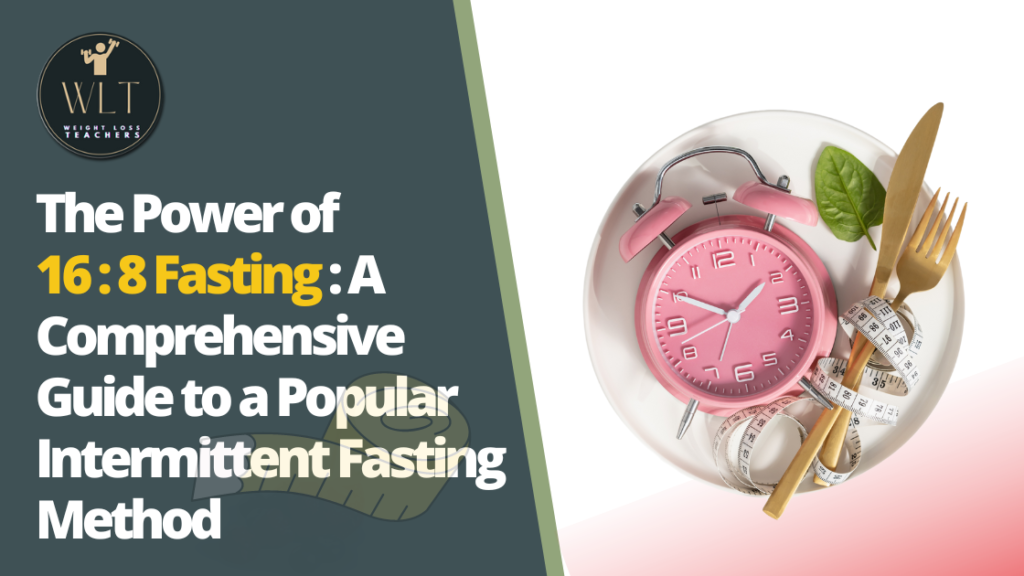
The Power of 16:8 Fasting: A Comprehensive Guide to a Popular Intermittent Fasting Method

In recent years, intermittent fasting has gained significant attention for its potential health benefits and weight management. Among the various fasting protocols, the 16:8 fasting method has emerged as a popular approach.
Table of Contents
Introduction
With its simplicity and flexibility, 16:8 fasting has attracted many individuals looking to improve their overall well-being. This comprehensive guide aims to explore the science behind 16:8 fasting, its potential benefits, practical implementation, and considerations for successful adherence. So, let’s delve into the world of 16:8 fasting and discover how it can positively transform your life.
16:8 Fasting
Section 1: Understanding Intermittent Fasting

1.1 What is Intermittent Fasting?
Intermittent fasting is an eating pattern that involves alternating periods of fasting and eating. It doesn’t focus on what you eat but rather when you eat. By restricting the eating window, intermittent fasting allows the body to experience periods of calorie restriction and metabolic changes.
1.2 Different Types of Intermittent Fasting
There are several different types of intermittent fasting, including the 16:8 method, which is the focus of this article. Other popular variations include the 5:2 method, where you eat normally for five days and limit calorie intake to 500-600 calories on two non-consecutive days, and the alternate-day fasting method, which involves fasting every other day.
1.3 The Science behind Intermittent Fasting
Intermittent fasting triggers various physiological changes in the body. During the fasting period, insulin levels decrease, and the body starts using stored fat for energy. This leads to fat burning and can contribute to weight loss. Additionally, fasting activates cellular repair processes, such as autophagy, which removes damaged cells and promotes cellular regeneration.
1.4 Benefits of Intermittent Fasting
Intermittent fasting has been associated with numerous health benefits. Research suggests that it may promote weight loss and improve metabolic health by reducing insulin resistance and promoting fat burning. Intermittent fasting has also been linked to enhanced brain function, increased longevity, improved heart health, reduced inflammation, and potential protection against certain chronic diseases like diabetes and cancer.
Section 2: Unveiling 16:8 Fasting

2.1 What is 16:8 Fasting?
16:8 fasting involves fasting for 16 hours each day and restricting eating to an 8-hour window. Typically, individuals choose to skip breakfast and start eating around noon, continuing until 8 p.m. This approach allows for consistency and ease of adherence, as the fasting period mainly occurs during sleep.
2.2 How Does 16:8 Fasting Work?
During the 16-hour fasting period, the body depletes glycogen stores and shifts to using stored fat as an energy source. This metabolic shift can aid in weight loss and improve insulin sensitivity. The 8-hour eating window provides an opportunity to consume adequate nutrients and calories within a compressed timeframe.
2.3 History and Origins of 16:8 Fasting
While intermittent fasting has been practiced for centuries in various cultures and religions, the 16:8 fasting method gained popularity more recently. It has roots in the concept of time-restricted feeding and was popularized by fitness experts and health influencers who recognized its simplicity and potential benefits.
2.4 Popular Celebrities and Public Figures who Practice 16:8 Fasting
Many well-known celebrities and public figures have embraced intermittent fasting, including 16:8 fasting. Prominent individuals like Hugh Jackman, Terry Crews, and Jennifer Aniston have shared their positive experiences with this fasting protocol, further increasing its popularity and visibility.
Section 3: The Benefits of 16:8 Fasting

3.1 Weight Management and Fat Loss
One of the primary benefits of 16:8 fasting is its potential for weight management and fat loss. By restricting the eating window, individuals tend to consume fewer calories overall. Additionally, the metabolic shift during the fasting period promotes fat burning and can contribute to sustainable weight loss over time.
3.2 Improved Insulin Sensitivity
Insulin sensitivity refers to how effectively the body utilizes insulin to regulate blood sugar levels. Research suggests that 16:8 fasting can improve insulin sensitivity, potentially reducing the risk of insulin resistance and type 2 diabetes. By giving the body regular periods of rest from digesting food, 16:8 fasting allows insulin levels to stabilize.
3.3 Enhanced Energy Levels and Mental Clarity
Many individuals who practice 16:8 fasting report increased energy levels and improved mental clarity. This may be attributed to the metabolic adaptations that occur during the fasting period, as well as the elimination of blood sugar spikes and crashes associated with frequent eating.
3.4 Autophagy
Cellular Cleansing and Regeneration Autophagy is a cellular process where damaged or dysfunctional cells are broken down and recycled. 16:8 fasting has been linked to the stimulation of autophagy, which promotes cellular cleansing and regeneration. This process may have anti-aging effects and could potentially reduce the risk of age-related diseases.
3.5 Potential Anti-Aging Effects
Intermittent fasting, including 16:8 fasting, has shown promise in promoting longevity and anti-aging effects. By reducing oxidative stress, inflammation, and insulin resistance, fasting may help protect against age-related diseases and contribute to overall healthspan.
3.6 Reduced Inflammation and Chronic Disease Risk
Chronic inflammation is associated with various diseases, including heart disease, diabetes, and certain cancers. 16:8 fasting has been shown to reduce inflammation markers in the body, potentially lowering the risk of developing chronic diseases and promoting overall health.
3.7 Cognitive Function and Brain Health
Emerging evidence suggests that 16:8 fasting may have positive effects on cognitive function and brain health. Animal studies have shown that intermittent fasting can increase the production of brain-derived neurotrophic factor (BDNF), a protein that promotes the growth and protection of brain cells.
3.8 Other Potential Benefits of 16:8 Fasting
While more research is needed, 16:8 fasting has been associated with several other potential benefits, including improved digestion, hormonal balance, immune function, and cardiovascular health. These areas warrant further investigation to better understand the full scope of benefits that 16:8 fasting may offer.
Section 4: Implementing 16:8 Fasting

4.1 Step-by-Step Guide to Starting 16:8 Fasting
To start 16:8 fasting, follow these steps:
- Choose a suitable 8-hour eating window that fits your schedule.
- Gradually increase fasting duration by delaying breakfast or advancing dinner.
- Stay hydrated during fasting periods by consuming water, herbal tea, or black coffee.
- Plan balanced meals within the 8-hour eating window to meet your nutritional needs.
4.2 Setting Personalized Fasting and Eating Windows
It’s important to personalize your fasting and eating windows to suit your lifestyle and preferences. Experiment with different schedules to find what works best for you. Some individuals prefer an early eating window, while others find it more convenient to have a later eating window. Flexibility is a key advantage of 16:8 fasting.
4.3 Preparing Your Meals for 16:8 Fasting
Meal planning plays a crucial role in successful implementation of 16:8 fasting. Focus on whole, nutrient-dense foods that provide a balance of macronutrients and micronutrients. Include lean proteins, healthy fats, complex carbohydrates, and plenty of fruits and vegetables. Preparing meals in advance can help you make healthier choices during the eating window.
4.4 Hydration and Supplementation
During Fasting Staying hydrated is essential during the fasting period. Drink plenty of water and consider herbal teas or black coffee, as they are low in calories and can help curb hunger. Some supplements, such as electrolytes and multivitamins, may be beneficial to ensure adequate nutrient intake during the eating window. Consult with a healthcare professional before starting any supplements.
4.5 Combining 16:8 Fasting with Exercise and Physical Activity
Exercise can be incorporated into your routine during both fasting and eating windows. Light to moderate intensity exercises, such as walking or yoga, can be performed during the fasting period. More intense workouts may be better suited for the eating window to ensure optimal energy levels. Listen to your body and adjust your exercise routine accordingly.
4.6 Overcoming Challenges and Staying Motivated
While 16:8 fasting is relatively simple, it can still present challenges. Hunger and cravings may arise, especially in the beginning. To overcome these challenges, stay hydrated, consume fiber-rich foods to promote satiety, distract yourself with activities, and seek support from friends or online communities. Tracking progress, celebrating milestones, and focusing on the benefits can help you stay motivated on your fasting journey.
Section 5: Who Should and Shouldn’t Try 16:8 Fasting?

5.1 Suitable Candidates for 16:8 Fasting
Generally, 16:8 fasting is considered safe for most healthy individuals. It may be suitable for those looking to manage their weight, improve insulin sensitivity, and promote overall health and well-being. However, it’s important to consider individual factors and consult a healthcare professional if you have any underlying health conditions or concerns.
5.2 Precautions and Considerations for Specific Groups
Certain groups may need to approach 16:8 fasting with caution or seek medical advice before starting, including:
- Individuals with diabetes or blood sugar regulation issues
- Pregnant or breastfeeding women
- Individuals with a history of eating disorders or disordered eating patterns
- Those taking medications that require food intake at specific times
- Athletes or individuals with high energy demands
5.3 Consulting a Healthcare Professional before Starting
Before starting 16:8 fasting, it’s recommended to consult with a healthcare professional, especially if you have any underlying health conditions or concerns. They can provide personalized guidance and help you determine if 16:8 fasting is suitable for you based on your individual circumstances.
Section 6: Frequently Asked Questions (FAQs) about 16:8 Fasting

6.1 Can I Drink Coffee or Tea During the Fasting Period?
Yes, you can consume coffee or tea during the fasting period as long as it’s consumed without added sugars, milk, or cream. Black coffee and unsweetened herbal teas are low in calories and can help curb hunger and provide a boost of energy.
6.2 Can I Take Medications or Supplements While Fasting?
It’s generally acceptable to take prescribed medications or supplements during the fasting period. However, it’s recommended to consult with your healthcare provider or pharmacist to ensure that your medication or supplements can be taken without food and won’t interfere with the fasting process.
6.3 How Long Does it Take to Adapt to 16:8 Fasting?
The adaptation period varies for each individual. Some people may adjust to 16:8 fasting within a few days, while others may take a couple of weeks. During the adaptation phase, you may experience hunger or fatigue, but these symptoms usually diminish as your body becomes accustomed to the fasting routine.
6.4 Can 16:8 Fasting Be Combined with Other Diets?
16:8 fasting can be combined with various dietary approaches, such as the ketogenic diet, Mediterranean diet, or plant-based diet. It’s important to focus on consuming balanced, nutrient-dense meals during the eating window, regardless of the specific diet you choose to follow.
6.5 Is 16:8 Fasting Safe for Pregnant or Breastfeeding Women?
Intermittent fasting, including 16:8 fasting, is not recommended for pregnant or breastfeeding women. During these stages, it’s crucial to provide sufficient nutrients and energy for the mother and the baby. It’s best to consult with a healthcare professional for appropriate nutrition guidance during pregnancy and breastfeeding.
Section 7: Common Myths and Misconceptions about 16:8 Fasting

7.1 Myth #1: Breakfast is the Most Important Meal of the Day
Contrary to popular belief, skipping breakfast as part of 16:8 fasting does not negatively impact health. The importance of breakfast varies from person to person, and research has shown that the timing of meals does not significantly affect overall health or weight management.
7.2 Myth #2: Fasting Leads to Muscle Wasting
When practiced correctly, 16:8 fasting does not lead to muscle wasting. In fact, intermittent fasting has been shown to preserve muscle mass while promoting fat loss. Regular exercise, especially resistance training, can help maintain and build muscle even while fasting.
7.3 Myth #3: Fasting Slows Down the Metabolism
Short-term fasting, such as 16:8 fasting, does not significantly slow down the metabolism. In fact, intermittent fasting can enhance metabolic flexibility and improve metabolic health. However, prolonged fasting or extreme caloric restriction may temporarily reduce metabolic rate.
7.4 Myth #4: Fasting Causes Nutritional Deficiencies
When done properly, 16:8 fasting allows for adequate nutrient intake during the eating window, reducing the risk of nutritional deficiencies. It’s important to prioritize a balanced diet and include a variety of nutrient-dense foods to meet your nutritional needs.
7.5 Myth #5: Fasting is only for Weight Loss
While weight loss is a common goal associated with fasting, 16:8 fasting offers numerous other benefits beyond weight management. These include improved insulin sensitivity, increased energy levels, enhanced cognitive function, and potential anti-aging effects. Weight loss is just one aspect of the overall health improvements that can be achieved through 16:8 fasting.
Section 8: Success Stories and Testimonials from 16:8 Fasting Practitioners

8.1 Real-life Stories of Weight Loss and Health Improvements
Numerous individuals have shared their success stories with 16:8 fasting, showcasing significant weight loss, improved health markers, increased energy, and overall well-being. These testimonials provide firsthand accounts of the transformative effects that 16:8 fasting can have on personal lives and habits.
8.2 How 16:8 Fasting Transformed Personal Lives and Habits
Many people have reported that 16:8 fasting has not only improved their physical health but has also had positive effects on their mental and emotional well-being. They have experienced increased self-discipline, improved relationship with food, and a greater sense of control over their eating habits.
8.3 Transformational Experiences and Long-term Benefits
For some individuals, 16:8 fasting has been a catalyst for long-term lifestyle changes. It has sparked a shift in their relationship with food and led to a more mindful and balanced approach to eating. The long-term benefits of weight management, improved energy levels, mental clarity, and overall health have been profound, creating lasting positive changes in their lives.
Conclusion
16:8 fasting has gained popularity for its simplicity, flexibility, and potential health benefits. By incorporating this intermittent fasting protocol into your lifestyle, you can experience weight management, improved energy levels, mental clarity, and numerous other advantages. Remember, it’s essential to personalize the fasting and eating windows to suit your individual needs and consult a healthcare professional if necessary. Embrace the power of 16:8 fasting and embark on a transformative journey towards better health and well-being.
Disclaimer: The information provided in this article is for educational purposes only and should not be considered as a substitute for medical advice. Consult a healthcare professional before implementing any home remedies or making significant changes to your lifestyle.






